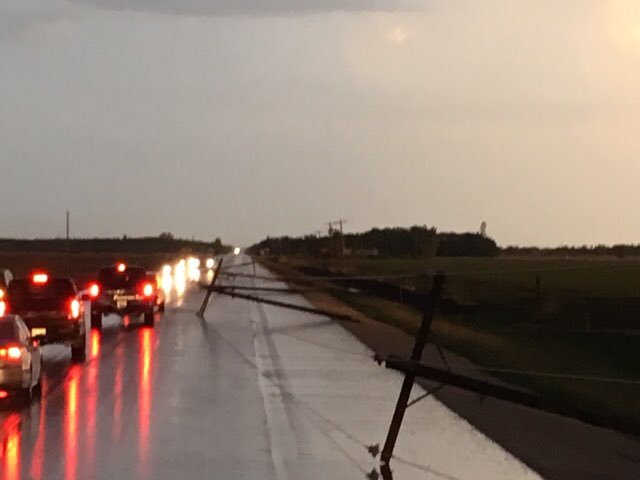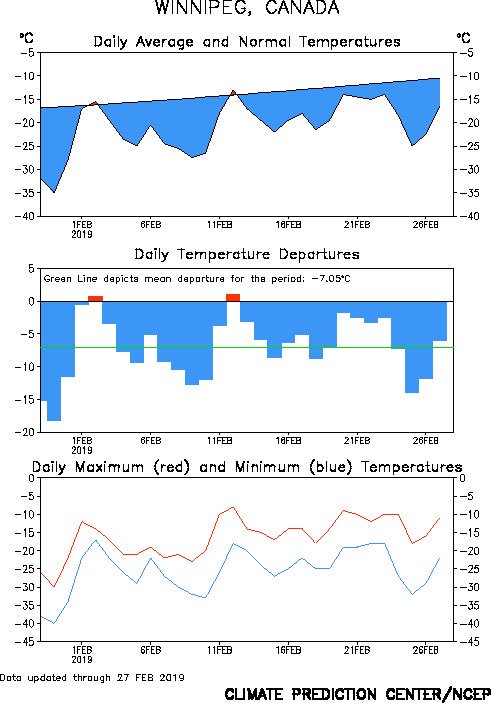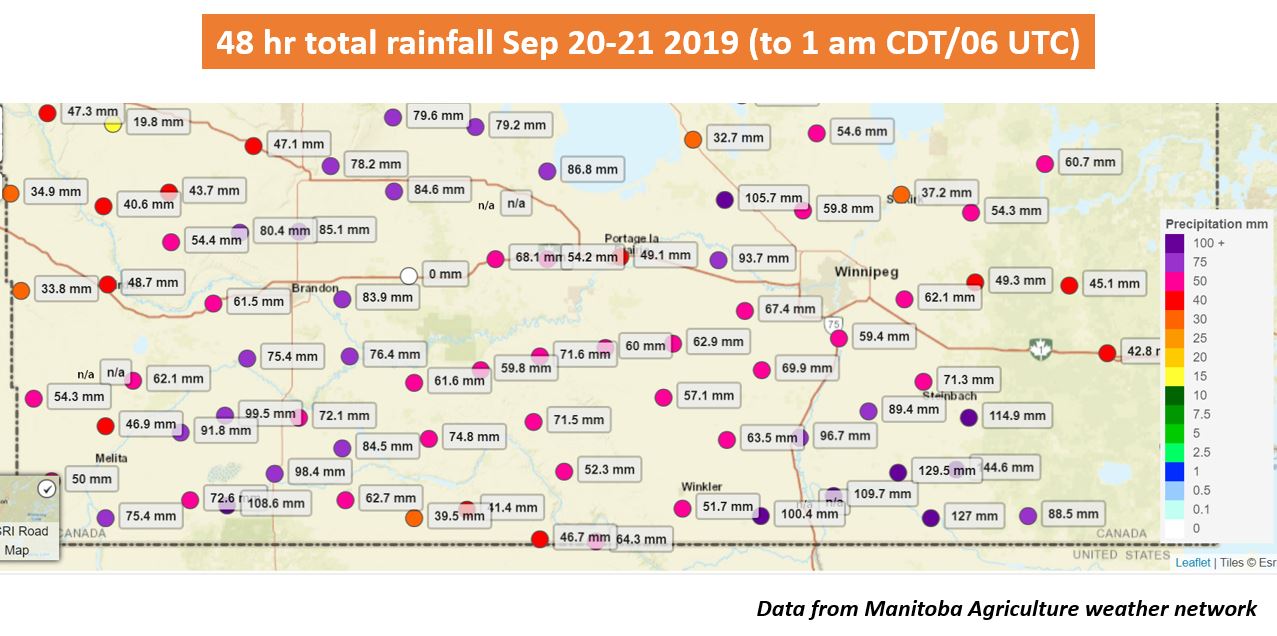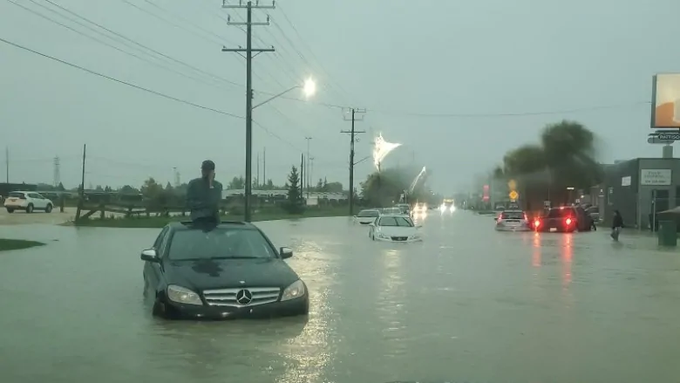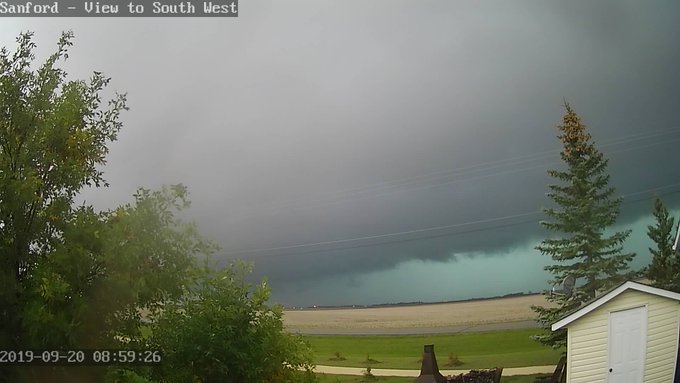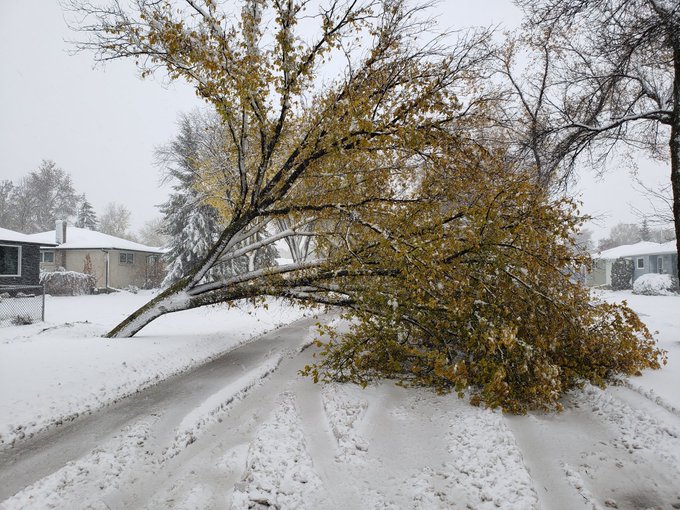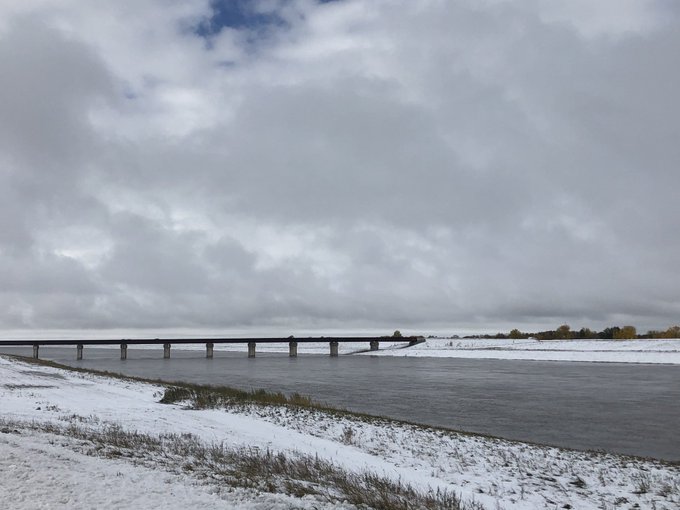10 - September 6 Damaging Wind Event
A low pressure system moved through southern Manitoba on September 6, producing damaging northwesterly winds on its back side. Wind gusts over 80 km/h knocked down trees and tree branches, commercial signage, fences and power lines. More than 19,500 customers lost power at some point due to the winds, from Pilot Mound to the Whiteshell and from the US border to Victoria Beach. More than 5,000 were still without power the next morning. Large waves and associated storm surge on Lake Manitoba and Lake Winnipeg also caused some damages along shorelines, such as to docks. Storm surge over 1.5 metres was predicted by the province.
9 - Snowiest April in 17 years
As has been the story of the past decade, April continued to be cold and snowy in 2020. This time, the story was especially the above normal snowfall. A total of 29.8 cm fell in Winnipeg, the snowiest April since 2003 and the 14th snowiest since 1872. The snow was spread out over mostly two events on Apr 2-3 and Apr 8.
During the Apr 2-3 event, 22.0 cm of snow fell in Winnipeg, the 7th largest 2-day snowfall in April since 1872. It was also the largest April snowstorm since 1999. 18.0 cm fell on April 2 alone, breaking the previous daily record of 9.8 cm in 1999. The storm system also spread heavy snowfall throughout the remainder of southern Manitoba, the Dakotas and parts of Saskatchewan. 25 cm fell in Grand Forks, ND.
On April 8, a small convective complex moved through the Red River Valley early in the afternoon producing impressive snowfall rates. 6 cm of snow fell at the Charleswood site in Winnipeg in only 1 hour. The snow quickly melted afterward with the sunshine. These higher snowfall amounts were quite localized given the convective nature of the event.
 |
| Visible satellite showing small convective snow complex through RRV April 8 posted by Rob |
April was also cold with a mean temperature of 1.7°C, tied 35th coldest and 2.8°C below normal. Thanks to a cold decade for Aprils, the month of April has cooled 0.7°C in the 1991-2020 normals compared to the 1981-2010 normals. It is tied with February for cooling the most. This is a large change in a short period of time, representative of a sudden or rapid change in climate.
8 - Record Late-Season Warmth and Humidity Highlights Warm Start to November
After a very cold second half of October, things turned around in the first 8 days of November to much warmer than normal. The first 8 days averaged 4.9°C, tied 11th warmest since 1872. Daytime highs were the most abnormally warm, averaging 13.0°C. This was about 10 degrees above normal, the 3rd warmest on record and warmest since 1975 for the period. 3 days exceeded 18°C, tied with 1903 for most in November since 1872. It was even warmer the further south you were. In Fargo, ND, 3 days exceeded 21°C (70°F) in November for the first time on record. On the Manitoba side, Emerson exceeded 20°C three times.
The abnormal conditions peaked on November 8, when a strong low pressure system moved into Manitoba from south of the border, briefly ushering in an unseasonably warm and humid air mass into southeastern Manitoba and the Red River Valley. As the warm front advanced northward, skies cleared and temperatures quickly climbed to close to 20°C. Combined with dewpoint values in the low double digits, this produced humidex values in the low twenties. These types of conditions were unprecedented this late in the season in Winnipeg. In fact, since 1953 there is no other comparable event, with this level of warmth and humidity, after October 27 (in 1989). The unusually high amount of humidity combined with cool surfaces resulted in condensation on roadways.
 |
| Graphical area forecast (GFA) issued by CMAC-W at ECCC valid 00Z Nov 9 |
The maximum temperature of 19.2°C at Winnipeg Airport on November 8 broke the daily record of 17.5°C in 1999 and was the latest date since 1872 to reach or exceed 19°C. Previously, the latest date was November 5. Dewpoint values reached 10.6°C, eclipsing the previous daily record of 6.7°C in 1969. It was the latest date to reach a double digit dewpoint since 1953, beating the previous latest date of November 7 set in 2016. Humidex reached 20.3 as well, only the second time since 1953 that humidex reached or exceeded 20°C in November. The only other time was on November 5, 1975. However, that occurrence was due to temperature solely, not due to humidity. Temperatures and dewpoints were even higher in southern parts of Winnipeg and south and east of the city. Temperatures reached as high as 21.4°C in Sprague, and dewpoint values as high as 13-14°C were observed.
The same system that brought the warmth and humidity on November 8 wrecked havoc throughout the rest of the Prairies. A massive blizzard crippled Saskatchewan and southern Alberta with 30 to 50 cm of snow and wind gusts up to or over 70 km/h. Saskatoon was among those hardest hit as the storm basically shut down the city and forced the city to postpone the municipal election. Flights were also cancelled, transit was suspended and leisure centres were closed. In western and central Manitoba, the system brought an exceptional ice storm with several hours of freezing rain that was heavy at times over a large area. Travel was trecherous with reports of rollovers. Power lines were sagging or downed, causing power outages.
 |
| McCreary, MB freezing rain Nov 9, by Josiah Preuter on Twitter |
7 - Hot and Humid Summer
To those who like summer weather, it was one of the nicest summers anybody could have asked for in Winnipeg. It mostly stayed warm right through June, July and August. Daytime highs averaged 26.4°C, tied 15th warmest. Overnight lows averaged 12.9°C, tied 18th warmest and the warmest since 2005. The mean temperature was 19.7°C, 1.3°C above normal and tied 15th warmest summer since 1873. 19 days exceeded 30°C during the 3-month period, 7 days above normal and tied 26th most since 1873. From June 23 to August 13, not a single day had a high cooler than 23°C, an amazing 52-day streak. In fact, the coolest day in July was 23.3°C, highest since 1964 and tied 3rd highest since 1873.
 |
| A perfect summer for the beach |
June was the most above normal month, averaging 18.7°C, tied 22nd warmest since 1872. Highs were most abnormal, averaging 25.4°C, 2.3°C above normal and more typical of July. 8 days exceeded 30°C, tied 12th most since 1872, and 6 days more than normal. The warmth peaked on June 17, when temperatures remained abnormally warm through the night. It was still 27.0°C at 4am, the warmest 4am temperature on record in June since 1953, and tied with August 1988 for warmest 4am temperature of all-time since 1953. 27.3°C at 3am also tied with 1996 for warmest in June since 1953.
July remained above normal, averaging 20.9°C, tied 25th warmest since 1873. Lows were most abnormal, averaging 14.7°C, 17th warmest. It was also tied for 5th most humid July since 1953, with an average dewpoint of 15.4°C. On July 24, Winnipeg reached peak #Mexipeg status as dewpoint values reached 25.1°C at the Airport, the 12th day of dewpoint over 25°C since 1953. It broke the daily record of 23.6°C in 1997. 25°C dewpoints have become increasingly over the past decade or two, now occurring about once every 3 years on average.
The warmth continued in August, albeit not as extreme relative to normal. With a mean temperature of 19.5°C, it was tied 34th warmest August.
South of the border, the summer was even more extreme in parts of North Dakota. In Fargo, ND, every single day in June, July and August exceeded 21°C (70°F) for the first time on record since 1881. Overall, the summer was tied with 1976 for 5th warmest since 1881 with a mean temperature of 21.8°C (71.3°F). Bismarck, ND recorded its 3rd warmest summer with a mean temperature of 22.6°C (72.7°F).
6 - Delayed Spring Greenup Thanks to Unseasonable Cold in the First Half of May
It was a delayed spring for southern Manitoba in 2020, as temperatures dipped to record cold values in the first half of May. With several nights falling well below freezing, spring growth was stunted as gardens would not grow and grass would not green up as quickly as normal for May. Once it finally warmed up later in the month, green up resumed quickly as we transitioned to summer in little time. The first half of May (May 1 to 15) was the 9th coldest on record since 1872, with a mean temperature of 4.6°C, 4.8°C below normal for the period.
The cold was at its worst May 7 to 13. A total of 12 cold-related records were broken during this period at Winnipeg Airport: two record low temperatures, three record low wind chills, and 7 record low dewpoints (3 record lows and 4 record low maximums). The low of -10.3°C on May 11 was the coldest temperature for so late in the season since 1872, and the second latest date to dip into the minus double digits. Wind chill values dipped to -15.2 on the same date, the latest date since 1953 to see wind chill below -14 and eclipsing the daily record of -10.4 in 2005.
The dewpoint values were the most extreme during the cold spell, showing the exceptional dryness of the air for that time of year. The all-time (since 1953) lowest dewpoint record for May was broken twice, first on May 11 with -16.2°C, then on May 12 with -16.8°C. The previous record was -16.1°C on May 2, 1967. The fact these records occurred 10 days later in the season again proves the extremeness of the event. The records also broke the previous daily records by around 5°C. In addition, the maximum dewpoint on May 12 was only -10.9°C, the lowest on record for May since 1953, beating -9.8°C on May 6, 1989. It was also 6°C lower than the previous daily record set in 2013.
In spite of the cold, Winnipeg managed to avoid any snow in May. However, a clipper system on May 9 dumped 5 to 10 cm throughout southwestern Manitoba, including in Brandon.
 |
| Webcams through SW MB showing snow morning of May 9, via robsobs |
5 - Yet Another Cold October
It was yet another cold October across southern Manitoba. In fact, it was the third consecutive October to be in the top 30 coldest on record since 1872 in Winnipeg. This is the first time we've had three consecutive such Octobers, making it the coldest 3-year period for Octobers since 1872. The bulk of the cold was in the second half of the month (Oct 15-31) which was the 3rd coldest on record since 1872:
October was dominated by the cold in the second half. As a result, the month as a whole was tied with 1991 for 7th coldest October since 1872, with a mean temperature of 1.8°C. That was 3.3°C below normal, and tied with 1991 for 3rd coldest October in the past 100 years. Overnight lows were the most extreme relative to normal, averaging -3.8°C, tied 5th coldest on record since 1872. The average dewpoint was -3.7°C, 4.3°C below normal and the 3rd lowest since 1953.
In addition to the cold, the month was snowy, but luckily not as snowy as last year. 14.4 cm fell, 2.6 times the normal, making it the 26th snowiest October since 1872 and the 5th snowiest in the past 40 years. Much of the snow fell during the night of October 20-21, with 8.0 cm. The snow depth of 8 cm the morning of October 21 was a daily record, and was one of the deepest for so early in the season since 1955. Since 1955, only 2009 and 2019 had deeper snow packs during the early morning hours on an earlier date in the season. The snow caused slippery road conditions with multiple vehicles reportedly in ditches along the Trans Canada west of the city. Lake effect flurries also occurred as early as October 1, west and east of the city, but luckily missed the city.
The persistence of the cold weather pattern in October also resulted in persistent snow squalls off the lakes. Berens River was particularly hard hit with one of the snowiest months it has ever recorded. An estimated 91 to 105 cm of snow fell, mostly between October 17 and 26. Values are estimated and an exact value cannot be determined given the absence of a snow observer. Estimations are based on automated snow depth sensors in addition to weighing gauge precipitation amounts. The snowiest event started in the morning of October 17 and ended overnight on October 19, with most of the snow falling on October 18. Around 50 cm of snow fell during this event. Snowfall rates as high as around 6 cm per hour occurred. In addition, wind gusts reached up to 60-70 km/h at times, producing blowing snow and making snowfall amounts even more difficult to estimate. Snow on ground peaked at 64 cm in the evening of Oct 25, and at least 25 cm would remain on the ground right through the remainder of the year.
 |
| Berens River Airport burried by snow squalls. Webcam Oct 25, via Nav Canada |
4 - Warm Winter, and Year, with Few Days Below -20°C
In general, 2020 was a year of warm winter months with a very notable lack of cold days. There were only 32 days below -20°C in 2020, tied with 1878, 1915 and 2006 for 3rd fewest on record since 1872. It was 21 days fewer than the normal of 53 days.
Winter 2019-2020 was tied 24th warmest since 1872 with a mean temperature of -12.8°C, 1.7°C above normal. There were only 35 days below -20°C, tied 13th fewest since 1872. There were only 4 days of -30°C, tied 10th fewest. Normals are 45 days and 13 days respectively. The winter continued a long-term trend toward fewer very cold days in Winnipeg. Over the past decade, Winnipeg averaged 9 days of -30°C per year, significantly less than the 1981-2010 normal of 14 days.
January 2020 was the 12th warmest on record since 1872 with a mean temperature of -12.5°C, 3.9°C above normal. Daily lows were even more impressive, tied 10th warmest with an average low of -16.7°C, 4.8°C above normal. With just 1 day of -30°C and 10 days of -20°C, these were tied 5th fewest and 6th fewest respectively, since 1872. February was near normal but still mild historically at 34th warmest. Interestingly, the AO index reached its highest daily value on record since records began in 1950, of +6.5 on February 21.
Thanks to warm winter months, as well as summer months, 2020 was tied 18th warmest year on record since 1873 with a mean temperature of 3.6°C, 0.7°C above normal. The climate remains the warmest it has ever been, with the new 1991-2020 normals continuing with an average yearly mean temperature of 2.9°C.
3 - Mild, Rainy First Half of December with Bare Fields
Real winter wasn't anywhere to be found across southern Manitoba in the first half of December, which felt bizarre given the development of a moderate to strong La Niña this winter. Temperatures were persistently mild, it rained more than it snowed, and snow was difficult to find as fields remained mostly bare throughout a large portion of southern Manitoba. This kind of weather was more typical of the first half of November. The snow and cold did finally reach Manitobans just before Christmas, but not before some impressive numbers came out of the warm spell.
Every single of the first ten days of the month exceeded the freezing mark at Winnipeg Airport, the first time on record this has been observed in the city since 1872. In fact, the first ten days of December were the 3rd warmest on record since 1872 with a mean temperature of -2.2°C, almost 10°C above normal. Only 1913 and 1939 were warmer, both of which had a green Christmas. Daily highs averaged 3.1°C, the 2nd warmest since 1872. Only 1939 was warmer with a 3.6°C average. Despite the extreme warmth, only one temperature record was broken: a high of 6.7°C on Dec 8 broke the old record of 5.6°C in 1928 and 1939. Some instances of double digits did occur in southern Manitoba during the wram spell, such as 10.1°C in McCreary on Dec 8.
 |
| 3rd warmest first 10 days of December since 1872, image by Rob Paola on Twitter |
During the first 12 days of the month, only one day dipped below -10°C and the coldest temperature was only -10.6°C, amazing when you consider the normal high for the period is close to -8°C or so. The ten-consecutive days of highs above freezing also broke the previous longest December streak of 8 days in December 1877, which was Winnipeg's warmest December on record. However, that 1877 December did had 11 consecutive days with temperatures at or above freezing (0.0°C or above).
There was barely any snow to be seen across southern Manitoba throughout the period with only small patches here and there, mainly in ditches and shaded areas. The Winnipeg Charleswood site recorded trace snow depth for most of the first 12 days of the month, with snow depth dropping to 0 cm on Dec 10 and 11 thanks to rainfall. Only 6 other years since 1955 have seen 0 cm snow depth that late in the season: 1974, 1982, 1987, 1998, 1999 and 2002. This averages out to about once per decade.
 |
| Rosser webcam just NW of Wpg on Dec 11 showing no snow on ground |
On the night of Dec 9-10, a clipper system moved through southern Manitoba dropping with it a rare December steady rainfall. 4 to 5 mm of rain was recorded in Winnipeg, with a rate of just over 1 mm per hour recorded at the peak of the event. The only other comparable rainfall events occurring this late in the season were in 1877, 1939 and 1959. Rain and freezing rain/drizzle occur often in the middle of winter, but rarely of this intensity and amount. The highest rainfall amounts actually fell south of the Trans Canada with a general 6 to 12 mm observed. Rainfall rates were as high as 2-3 mm per hour through that swath.
Some cold weather finally arrived just before Christmas, with Winnipeg's first -20°C of the season observed the night of Dec 13-14. Dec 14 ended a 20-day streak of above normal temperatures.
In the end, December averaged -8.4°C, tied 12th warmest since 1872. Highs were even more extreme, averaging -3.3°C, tied 6th warmest. In addition, after another 0.4 mm of rain on Dec 19, December became the 6th rainiest on record since 1872 with 4.4 mm. It was also the rainiest since 1987.
2 - Summer of Floods & Tornadoes in Southern Manitoba, but Uneventful in Winnipeg
It was yet again another benign summer weather-wise in Winnipeg. There were only 21 thunderstorm days at the Airport in 2020, the 4th consecutive year to see below normal thunderstorm activity (normal 26 days) and the 12th below normal year in the past 13 years. There were still some significant thunderstorm events in parts of southern Manitoba however, with damaging floods and tornadoes that were the biggest weather events of the year across southern Manitoba.
 |
| Flooded field between Portage & Elie. By Günter on Twitter. |
On June 7 and 8, a series of heavy thunderstorms pounded extreme southeastern Manitoba, dumping copious amounts of rain which lead to exceptional flooding. As much as 170 mm of rain fell in less than 36 hours, along with hail as large as ping pong balls. Here are some rainfall amounts from the event:
 |
| Flood in SE Mb, by Steinbach Online with Mountain City Aviation |
 |
| Brandon, by Quinn Melnyk |
In addition to the rainfall, an EF-2 tornado narrowly missed Rapid City, but still damaged some properties just southeast of the village. Luckily, there were no injuries. Strong winds and large hail also occurred in some instances, with ping pong ball sized hail around Wasagaming, and gusts to 87 km/h in Brandon and 97 km/h at Moosehorn.
In Minnedosa, about 60 people were forced to evacuate due to the Little Saskatchewan River overflowing its banks. High water levels destroyed a footbridge, washed out roads and flooded basements. The town also removed some of the logs from the local dam in order to release water from the lake to relieve pressure on the dam. Several municipalities throughout southwestern Manitoba issued states of emergency. In Rapid City, the dam along the Little Saskatchewan River breached. The breach means it can no longer hold water, causing concerns about wells in the area running dry because the province announced the dam would not be fully replaced until 2022. In the Rivers area, Lake Wahtopanah rose to record levels, flooding out properties along Chimo Beach. More than 100 people downstream of the Rivers dam were recommended to evacuate due to the province not being confident that the dam would be able to hold. Engineers remained on site 24/7 to monitor the dam. The Manitoba Infrastructure Minister called the flooding a once-in-1,000 year event. Luckily, the Rivers dam held throughout the event despite handling three times its typical water volume. The City of Brandon also made flood preparations in case of rising water levels along the Assiniboine.
 |
| Flooded out road leading to Brandon Airport, by rcmpmb |
Overland flooding also blocked off the road leading to Brandon Airport from the east. Anybody needing to access the airport was asked to detour from the west. Several sections of highways and grid roads throughout southwestern Manitoba were closed due to overland flooding, including sections of highway 10 and briefly the Trans Canada east of Brandon. Closures made it difficult for rural residents and farmers to get around and overland flooding destroyed some crops. Flooding also delayed the restoration of power after outages caused by the storms.
Further east, a flood warning was issued for the Whitemud River, with the Town of Neepawa issuing a local state of emergency. The town had issued an urgent plea for volunteer sand baggers and some properties evacuated. The Park Lake dam in Neepawa also breached due to the flooding. The Portage Diversion was operated to limit water flow downstream of the Assiniboine.
In the end, Brandon recorded 221.6 mm of rain in June, the 2nd wettest June on record. Interestingly, the wettest was not that long ago, back in 2014, with 251.6 mm. The Rivers-Pettapiece station recorded an unbelievable 340.0 mm.
On August 7, a photogenic but deadly EF-3 tornado touched down near Scarth in southwestern Manitoba. Two vehicles along highway 83 were struck by the tornado, with Stars Air Ambulance being called to the scene. Two recent high school graduates from the Melita area died as their vehicle was tossed by the tornado. This was the first tornado-related death in Canada since the Alonsa, MB tornado in 2018, and the deadliest since 2009. It was also the first tornado to cause multiple deaths in Manitoba since the Rosa-St Malo tornado of 1977. The tornado also damaged a farm property, where luckily no one was home at the time, in addition to knocking over power lines. The driver in the second vehicle was also seriously injured as his vehicle was tossed by the tornado.
1 - Driest Year on Record ?? Or 9th Driest ?
2020 was yet another exceptionally dry year in the series of dry years we have had the past decade. Due to undercatch of winter precipitation at the Airport, it is difficult nowadays to determine exactly how much precipitation has fallen. In my corrected dataset, I use The Forks whenever possible for snow-water equivalent as it undercatches significantly less than the Airport (possibly no longer an issue now due to a new gauge installed in November, but some time is needed to confirm this). Using this method, I end up with 304.8 mm of precipitation for 2020, which would make it the driest year on record since 1873, beating 320.9 mm in 1961.
However, if we assume a 10:1 ratio throughout Winnipeg's climate history (1872-present), 2020 becomes the 9th driest year with 378.0 mm, and the driest since 1961. The reason for this difference is because snow-water equivalent measuring did not begin until the 1960s. Therefore, assuming a 10:1 ratio might be a more accurate way of determining the year's truer rank historically.
Regardless, a number of milestones and impressive numbers were reached in 2020 with respect to the dryness:
- 3rd driest February (2.8 mm)
- 2nd driest winter (23.5 mm)
- 15th driest spring (58.8 mm) and 14th least rainy (34.8 mm)
- 33rd driest summer (172.0 mm)
- 21st driest September (19.4 mm)
- 18th least rainy October (5.9 mm)
- 8th driest November (4.9 mm)
- 3rd driest fall (39.4 mm) and 7th least rainy (26.6 mm)
- 5th least rainy year (237.8 mm)
- Driest year on record?? Or 9th driest?
The dryness of 2020 followed on the heels of the other exceptionally dry years of 2017 and 2018, and to a certain extent 2019 (except for the wet fall). 2017 was the 4th driest year, 2018 had the driest January to April on record and 2019 had the driest January to August on record. The long dry spell has caused soils to shift significantly in Winnipeg, causing damage to infrastructure such as sidewalks and homes.












